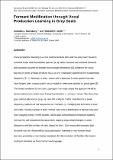Files in this item
Formant modification through vocal production learning in gray seals
Item metadata
| dc.contributor.author | Stansbury, Amanda | |
| dc.contributor.author | Janik, Vincent M. | |
| dc.date.accessioned | 2020-06-19T23:34:48Z | |
| dc.date.available | 2020-06-19T23:34:48Z | |
| dc.date.issued | 2019-07-08 | |
| dc.identifier | 259313880 | |
| dc.identifier | 98200785-3a9e-41b7-8179-257c4946923a | |
| dc.identifier | 85068174305 | |
| dc.identifier | 000474514400034 | |
| dc.identifier.citation | Stansbury , A & Janik , V M 2019 , ' Formant modification through vocal production learning in gray seals ' , Current Biology , vol. 29 , no. 13 , e4 , pp. 2244-2249 . https://doi.org/10.1016/j.cub.2019.05.071 | en |
| dc.identifier.issn | 0960-9822 | |
| dc.identifier.other | ORCID: /0000-0001-7894-0121/work/60427851 | |
| dc.identifier.uri | https://hdl.handle.net/10023/20112 | |
| dc.description.abstract | Vocal production learning is a rare communication skill and has only been found in selected avian and mammalian species [1, 2, 3, 4]. Although humans use learned formants and voiceless sounds to encode most lexical information [5], evidence for vocal learning in other animals tends to focus on the modulation pattern of the fundamental frequency [3, 4]. Attempts to teach mammals to produce human speech sounds have largely been unsuccessful, most notably in extensive studies on great apes [5]. The limited evidence for formant copying in mammals raises the question whether advanced learned control over formant production is uniquely human. We show that gray seals (Halichoerus grypus) have the ability to match modulations in peak frequency patterns of call sequences or melodies by modifying the formants in their own calls, moving outside of their normal repertoire’s distribution of frequencies and even copying human vowel sounds. Seals also demonstrated enhanced auditory memory for call sequences by accurately copying sequential changes in peak frequency and the number of calls played to them. Our results demonstrate that formants can be influenced by vocal production learning in non-human vocal learners, providing a mammalian substrate for the evolution of flexible information coding in formants as found in human language. | |
| dc.format.extent | 6 | |
| dc.format.extent | 1015121 | |
| dc.language.iso | eng | |
| dc.relation.ispartof | Current Biology | en |
| dc.subject | Vocal learning | en |
| dc.subject | Animal communication | en |
| dc.subject | Animal cognition | en |
| dc.subject | Bioacoustics | en |
| dc.subject | Halichoerus grypus | en |
| dc.subject | Pinnipeds | en |
| dc.subject | Animal music | en |
| dc.subject | GC Oceanography | en |
| dc.subject | QH301 Biology | en |
| dc.subject | DAS | en |
| dc.subject | BDC | en |
| dc.subject | R2C | en |
| dc.subject.lcc | GC | en |
| dc.subject.lcc | QH301 | en |
| dc.title | Formant modification through vocal production learning in gray seals | en |
| dc.type | Journal article | en |
| dc.contributor.institution | University of St Andrews. Sea Mammal Research Unit | en |
| dc.contributor.institution | University of St Andrews. Marine Alliance for Science & Technology Scotland | en |
| dc.contributor.institution | University of St Andrews. Scottish Oceans Institute | en |
| dc.contributor.institution | University of St Andrews. Institute of Behavioural and Neural Sciences | en |
| dc.contributor.institution | University of St Andrews. Centre for Social Learning & Cognitive Evolution | en |
| dc.contributor.institution | University of St Andrews. School of Biology | en |
| dc.contributor.institution | University of St Andrews. Bioacoustics group | en |
| dc.identifier.doi | https://doi.org/10.1016/j.cub.2019.05.071 | |
| dc.description.status | Peer reviewed | en |
| dc.date.embargoedUntil | 2020-06-20 |
This item appears in the following Collection(s)
Items in the St Andrews Research Repository are protected by copyright, with all rights reserved, unless otherwise indicated.

